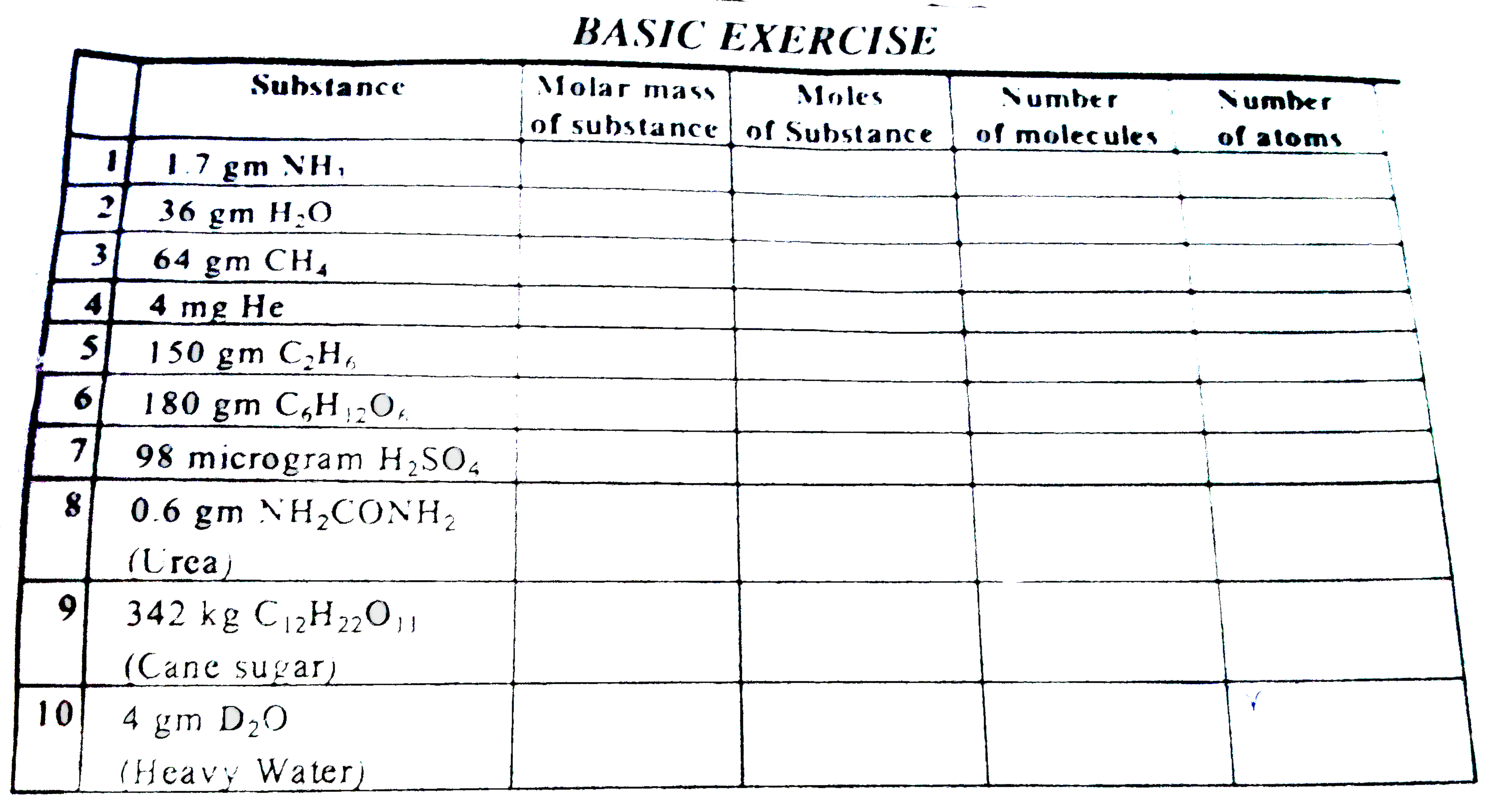For a gaseous phase reaction A+2B⇔AB2,Kc=0.3475L2mole−2 at 200∘C. When 2 moles of B are mixed with one "mole" of A, what total pressure is required to convert 60% of A in AB2?
The correct Answer is:A
To solve the problem step by step, we will follow the outlined approach in the video transcript while ensuring clarity and completeness.
Step 1: Write the Reaction and Initial Conditions
The given reaction is:
A+2B⇌AB2
Initially, we have:
- 1 mole of A
- 2 moles of B
Step 2: Define the Degree of Dissociation
We are told that 60% of A is converted into AB2. Thus, the degree of dissociation (α) is:
α=0.6
Step 3: Calculate Moles at Equilibrium
At equilibrium:
- Moles of A remaining = 1−α=1−0.6=0.4
- Moles of B remaining = 2−2α=2−2(0.6)=0.8
- Moles of AB2 formed = α=0.6
Step 4: Calculate Total Moles at Equilibrium
Total moles at equilibrium:
Total moles=Moles of A+Moles of B+Moles of AB2
=0.4+0.8+0.6=1.8
Step 5: Calculate Partial Pressures
Let P be the total pressure. The partial pressures can be calculated using the mole fractions:
- Partial pressure of A:
PA=(0.41.8)P
- Partial pressure of B:
PB=(0.81.8)P
- Partial pressure of AB2:
PAB2=(0.61.8)P
Step 6: Write the Expression for Kp
The equilibrium constant Kp for the reaction is given by:
Kp=PAB2PA⋅P2B
Substituting the expressions for partial pressures:
Kp=(0.61.8P)(0.41.8P)(0.81.8P)2
Step 7: Simplify the Expression
This simplifies to:
Kp=0.6P(0.4⋅0.821.83P3)
Kp=0.6⋅1.830.4⋅0.82⋅1P2
Step 8: Relate Kp and Kc
We know:
Kp=Kc⋅RΔn⋅TΔn
Where:
- Kc=0.3475L2mol−2
- R=0.0821L atm K−1mol−1
- T=200+273=473K
- Δn=moles of products−moles of reactants=1−3=−2
Step 9: Calculate Kp
Substituting the values:
Kp=0.3475⋅(0.0821⋅473)−2
Step 10: Solve for Total Pressure P
Equate the two expressions for Kp and solve for P:
0.3475⋅(0.0821⋅473)−2=0.6⋅1.830.4⋅0.82⋅1P2
After simplification, you will find:
P≈181.5atm
Final Answer
The total pressure required to convert 60% of A into AB2 is approximately:
P≈181.5atm
The given reaction is:
A+2B⇌AB2
- 1 mole of A
- 2 moles of B
We are told that 60% of A is converted into AB2. Thus, the degree of dissociation (α) is:
α=0.6
At equilibrium:
- Moles of A remaining = 1−α=1−0.6=0.4
- Moles of B remaining = 2−2α=2−2(0.6)=0.8
- Moles of AB2 formed = α=0.6
Total moles at equilibrium:
Total moles=Moles of A+Moles of B+Moles of AB2
=0.4+0.8+0.6=1.8
Let P be the total pressure. The partial pressures can be calculated using the mole fractions:
- Partial pressure of A:
PA=(0.41.8)P
- Partial pressure of B:
PB=(0.81.8)P
- Partial pressure of AB2:
PAB2=(0.61.8)P
The equilibrium constant Kp for the reaction is given by:
Kp=PAB2PA⋅P2B
Kp=(0.61.8P)(0.41.8P)(0.81.8P)2
This simplifies to:
Kp=0.6P(0.4⋅0.821.83P3)
Kp=0.6⋅1.830.4⋅0.82⋅1P2
We know:
Kp=Kc⋅RΔn⋅TΔn
Where:
- Kc=0.3475L2mol−2
- R=0.0821L atm K−1mol−1
- T=200+273=473K
- Δn=moles of products−moles of reactants=1−3=−2
Substituting the values:
Kp=0.3475⋅(0.0821⋅473)−2
Equate the two expressions for Kp and solve for P:
0.3475⋅(0.0821⋅473)−2=0.6⋅1.830.4⋅0.82⋅1P2
P≈181.5atm
The total pressure required to convert 60% of A into AB2 is approximately:
P≈181.5atm
Topper's Solved these Questions
- CHEMICAL EQUILIBRIUMBOOK - CENGAGE CHEMISTRY ENGLISHCHAPTER - CHEMICAL EQUILIBRIUMEXERCISE - Exercises (Linked Comprehensive)
54 Videos
- CHEMICAL EQUILIBRIUMBOOK - CENGAGE CHEMISTRY ENGLISHCHAPTER - CHEMICAL EQUILIBRIUMEXERCISE - Exercises (Multiple Correct)
26 Videos
- CHEMICAL EQUILIBRIUMBOOK - CENGAGE CHEMISTRY ENGLISHCHAPTER - CHEMICAL EQUILIBRIUMEXERCISE - Ex 7.2
40 Videos
- CHEMICAL BONDING AND MOLECULAR STRUCTUREBOOK - CENGAGE CHEMISTRY ENGLISHCHAPTER - CHEMICAL BONDING AND MOLECULAR STRUCTUREEXERCISE - Archives Subjective
15 Videos
- CLASSIFICATION AND NOMENCLATURE OF ORGANIC COMPOUNDSBOOK - CENGAGE CHEMISTRY ENGLISHCHAPTER - CLASSIFICATION AND NOMENCLATURE OF ORGANIC COMPOUNDSEXERCISE - Analytical and Descriptive Type
3 Videos
Similar Questions
Knowledge Check
In the reaction A+B⇔C+D, 4 moles of A
react with 4 moles of B and form 2 moles each of C and D. The value of Ke for the reaction isA2B3C1D1.56
For the reaction A+2B→C, 5 moles of A and 8 mole of B will produce
View SolutionFor the reaction A(g)+3B(g)⇔2C(g)at 27∘C, 2 moles of A, 4 moles of B and 6 moles of C are present in 2 litre vessel. If Kc for the reaction is 1.2, the reaction will proceed in :
View SolutionFor the reaction A(g)+3B(g)⇔2C(g)at 27∘C, 2 moles of A, 4 moles of B and 6 moles of C are present in 2 litre vessel. If Kc for the reaction is 1.2, the reaction will proceed in :
View SolutionFor the reaction A+2B→C,5moles of A and 8moles of B will produce :-
View SolutionThe equilibrium constant Kc for the reaction P4(g)⇔2P2(g) is 1.4 at 400∘C. Suppose that 3 moles of P4(g) and 2 moles of P2(g) are mixed in 2 litre container at 400∘C. What is the value of reaction quotient (Q) ?
View SolutionIn the reaction
4A+2B+3C→A4B2C3, what will be the number moles of product formed starting from one mole of A, 0.6 moles of B and 0.72 moles of C?
View SolutionFor the reaction A(g)+3B(g)⇔2C(g) at 27∘C.2 mole of A, 4 moles of B and 6 moles of C are present in 2 lit vessel. If Kc for the reaction is 1.2, the reaction will proceed in
View Solution

